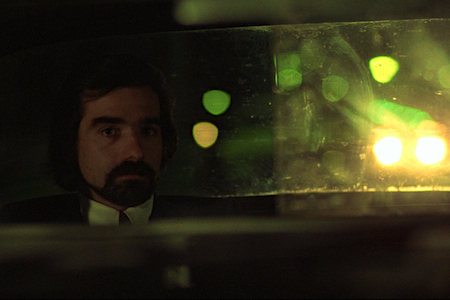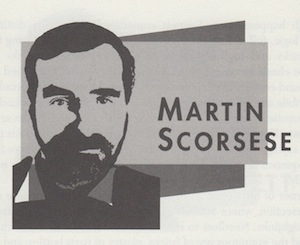
Born: November 7, 1942, New York, NY
His concern is what’s true to his characters and what’s right for their feelings.
—Steven Spielberg
Upon close examination of his career, Martin Scorsese appears to be two separate filmmakers. First and foremost, he is an obsessive student of cinema—hailing from a generation of college-educated filmmakers like Steven Spielberg, George Lucas and Francis Ford Coppola—who borrows heavily from past masters to produce highly effective movies. On the other hand, most of Scorsese’s work contains a sense of raw, unschooled direction that is truly rare among today’s filmmakers. His unsurpassed knowledge of film history has allowed him to subtly and skillfully make well-established techniques seem completely original and has helped him enlist the talent’s of Hollywood’s forgotten craftsmen. He has directed some of cinema’s finest films—Taxi Driver (1976), Raging Bull (1980) and Goodfellas (1990)—and his celebrated body of work is often credited with establishing a “modern cinema,” a major shift in moviemaking trends of the last thirty years that has seen the proliferation of films that disregard conventional narrative structure and emphasize character over plot.
In his youth, Scorsese suffered from a series of ailments that kept him close to home in the Little Italy section of New York City. Believing himself to be destined for the clergy, he studied at a Catholic seminary for one year before his interest in filmmaking led him to New York University. In 1964, he received a bachelor’s degree in film communication; then spurred on by praise of his It’s Not Just You, Murray (1966) and other short films, he stayed at NYU to complete his master’s degree while editing the rockumentary Woodstock (1970). Eventually, Scorsese would return to the university to teach filmmaking and film history classes, inspiring such budding student directors as Oliver Stone and Spike Lee.
Already present in Scorsese’s early films were his trademark verité style and kinetic camera work, as well as his authentic view of small-time Italian-American hustlers. Who’s That Knocking at My Door? (1967) showed what the talented new director could accomplish on a small budget. This attracted the attention of legendary B-movie producer Roger Corman, who asked Scorsese to leave New York for the backlots of Hollywood. Corman was interested in a sequel to his hit Bloody Mama (1970), and Scorsese was eager to test the waters in Tinseltown. The result was Boxcar Bertha (1972), a directing job critics labeled “yet another Bonnie and Clyde clone,” but nevertheless a profitable venture for Corman.
Working under the tight constraints of a low-budget production gave Scorsese the savvy he needed to complete Mean Streets (1973). The film featured Robert De Niro and Harvey Keitel as young cousins becoming small-time hoodlums on the streets of New York. Although he shot most of the film in Los Angeles, Scorsese insistited that the exteriors of the city be captured in New York for authenticity, and his own autobiographical touches of street life in tenement neighborhoods gave the film added realism. Mean Streets became his breakthrough, was the hit of the crowds at the Chicago Film Festival and got Hollywood’s attention.
Editor’s note: The essays of Scott Smith’s 1998 book, The Film 100, are being republished in their entirety here on Keyframe, not as the last word on cinema, but as a starting point for further discussion. Please join the conversation. To view the entire Film 100 list and find links to all the essays, please visit Reintroducing the Film 100.
Suddenly, Scorsese was offered high-profile projects with the support of major studios. He had critical as well as box office success with the big-budget Alice Doesn’t Live Here Anymore (1974), a film with feminist overtones that struck a chord with audiences in the wake of women’s liberation and led to a popular television series, Alice. However, the characteristic touches that made Scorsese a promising talent were missing from most of his Hollywood films of the period, including the lukewarm New York, New York (1977). When he strays from the familiar settings and themes of his hometown, Scorsese films seem forced. His attempts at “mainstream” material, like The Color of Money (1986), the sequel to the 1961 classic The Hustler, and Scorsese’s 1991 remake of the classic Cape Fear (1962), often perform well at the box office but lack the power of his more personal films.
The streets of New York played a central role in the highly influential Taxi Driver (1976), from a script by Paul Schrader, a story about a Vietnam vet’s feelings of isolation and detachment from society. Robert De Niro plays psychotic Travis Bickle, a cabbie with a penchant for guns who fixates on a twelve-year-old prostitute played by Jodie Foster. The infamous bloodletting that concludes the film has become an indelible moment of American cinema, and the film’s intense character exposé is considered seminal in the modern cinema. The film entirely abandons traditional plot developments for a methodical, almost documentary, examination of Bickle’s troubled existence. The role of Travis Bickle made De Niro an international star and Schrader a sought-after screenwriter. Taxi Driver received the Palme d’Or at the Cannes Film Festival and was nominated for three Oscars.
Taxi Driver featured a haunting score by legendary film composer Bernard Herrmann, who died just days after completing it. It would also mark a series of “rediscoveries” instituted by Scorsese. To avoid trouble with the MPAA board over the film’s vivid bloodbath finale, Scorsese contacted special effects pioneer Linwood Dunn, who washed the negatives in sepia tones to tame the reddish hues to brown, which secured the film a favorable rating. Repeatedly throughout his career, Scorsese would use his vast knowledge of film’s legends to summon famed title designer Saul Bass, New Wave cinematographer Nestor Almendros and other artists of the past for his projects.
In 1980, Scorsese made what some believe to be his masterwork. Raging Bull told the real-life story of middleweight boxing champion Jake La Motta. The scenes filmed inside the ring, with their dreamlike imagery and gritty intensity, remain unsurpassed among boxing films, and De Niro’s performance has become almost as famous as the picture itself. For the fight sequences, De Niro worked with one of America’s foremost trainers; he was believed to be as fit as the top professional boxers. For the later scenes of an older La Motta, De Niro reportedly flew to Italy for three months of solid eating and gained over fifty pounds.
Raging Bull was instantly hailed as a classic, winning Scorsese the National Society of Film Critics Award for Best Director. However, despite being nominated for seven Academy Awards, including Best Director, the film picked up only two Oscars, one for De Niro’s performance and one for Thelma Schoonmaker for editing.
The collaboration of Scorsese and De Niro continued in The King of Comedy (1983). Overall, they have made eight films together; although Scorsese tends to use actors repeatedly, like Harvey Keitel, Teri Garr, Barbara Hershey, Nick Nolte, Rosanna Arquette and Joe Pesci, no other actor has been as closely identified with Scorsese’s most successful films. Scheduling problems prevented De Niro from taking the role of Jesus in Scorsese’s controversial The Last Temptation of Christ (1988). The Paul Schrader script, based on the novel by Nikos Kazantzakis, was a pet project that Scorsese had nurtured for nearly a decade before shooting began. His interpretation of the life of Christ, played by Willem Dafoe, explored Christ’s final days and became an international scandal, as religious groups declared it blasphemous. Riots accompanied many screenings, and theater chains refused to book it. During the troubled production, Scorsese decided to supplement his income with experimental projects, including an episode of Steven Spielberg’s TV series Amazing Stories, several commercials for fashion designer Giorgio Armani, and Michael Jackson’s 1987 music video “Bad.”
As his stature as a prominent filmmaker increased, Scorsese began producing films, including The Grifters (1990), Mad Dog and Glory (1993) and Clockers (1995). With his direction of Goodfellas (1990), Scorsese returned to familiar territory. Based on the book Wiseguys by Nicholas Pileggi, it is the story of gangster Henry Hill, a real-life informer who revealed the inner workings of the Mafia to Pileggi. The brutal tale, filled with excellent performances by Pesci, De Niro and newcomer Ray Liotta, proved to be extremely popular, and Scorsese was nominated for a Best Director Oscar, as well as receiving awards from the National Society of Film Critics, New York Film Critics and L.A. Film Critics for Best Director. He returned to mobsters with Casino (1995), an account of the final days of organized crime in Las Vegas.
A lasting achievement of Martin Scorsese, and one that has endeared him to film lovers, was the establishment of the Film Foundation in 1990. Dedicated to ensuring the survival of America’s film heritage, the organization, headed by Scorsese and cofounded by George Lucas, Steven Spielberg, Woody Allen, Francis Ford Coppola, Stanley Kubrick, Robert Redford and Sydney Pollack, supports a public crusade for the preservation of film that Scorsese has led since 1979. His campaign for more lasting films resulted in the creation of a new Eastman Kodak color film stock that will not fade as quickly as the current stocks. Scorsese also initiated the fight against Ted Turner and the colorization of black-and-white films, denouncing the process as a threat to America’s cultural heritage. He continues to resist what he calls “the physical erosion of the integrity of our cinema through its deliberate material alteration by producers, distributors and broadcasters in search of a fast buck.” In 1992, Scorsese addressed a congressional subcommittee on behalf of the Directors Guild of America, to champion the Film Disclosure Act, a bill that passed and that requires all films to be labeled when they have been altered for television or video distribution.
Martin Scorsese has proved to be one of cinema’s greatest artists and toughest champions. His box office success pales in comparison to some, but he is revered among aspiring filmmakers. Scorsese is generally considered to be one of the best American directors working today, although an Academy Award eluded him [Editor’s note: Scorsese had not received an Academy Award at the time of this writing, 1998. He won Best Director for the 2006 film The Departed; he has been nominated since that time as well.] He received a Lifetime Achievement Award from the American Film Institute in 1997, an honor usually bestowed on directors posthumously, and he holds the unique position of being a director widely praised and appreciated well before his career is over.
To read all the republished articles from ‘The Film 100,’ go to Reintroducing the Film 100 here on Keyframe.




